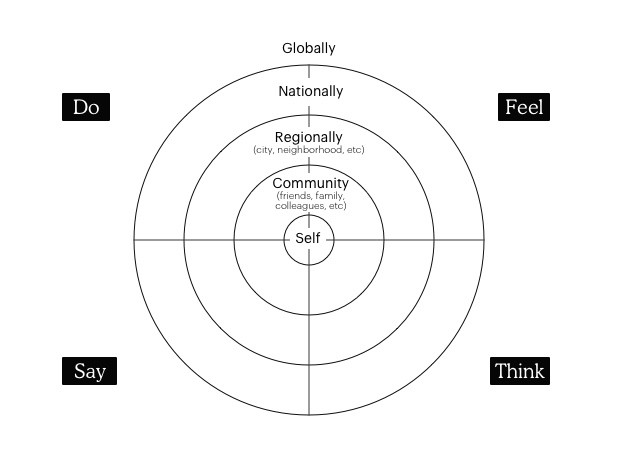Ethics Frameworks [WIP]
Frameworks for balanced teams considering the outcomes of the products they create
Exercises:
Product TimelineBeta
Yin-YangBeta
Do, Think, Feel, Say, EcosystemBeta
Issue-Contingent Model
(Coming Soon)
Do, Think, Feel, Say, Ecosystem
This exercise helps us as a team and as individuals think bigger, past building just for an individual user and into understanding how we may affect the greater ecosystem involved.
When to do this exercise:
Either before or after product has been built and released to users to help a team ideate and understand implications beyond just the individual.

How:
- View image provided above. Placed on a whiteboard, draw four concentric, circles expanding outward like a target. These circles represent the intended persona, their family & friends, the local community, their nation, and the larger global ecosystem.
- These circles are then each divided into a cross-section of 4 different areas:
- Think: understanding how each level is affects zeitgeist, implicit bias, world/political views, perception of others or groups of people, etc.
- Feel: understanding how each level is affects mental health, thoughts about themselves individually or collectively
- Say: understanding how each level affects speech, vocalization of opinions, or general communication
- Do: understanding how each level is affected in action or ability to engage
- Begin by putting 5 minutes on a timer and start with the inner most circle. Ask the group, “How will our product affect an individual user?” Have the team silently write one idea per Post-It note, making sure to cover all four quadrants of how this would affect what the individual does, how the individual might think, how they might feel, and what they might say given the definitions above.
- At the end of the 5 minutes, facilitate a structured discussion of the layer before moving on, asking individual volunteers in the group to share what they wrote in each of the four cross-sections, with the rest of the team. Allow their statements to generate productive discussion with the rest of the team for up to 10 minutes before moving on.
- As one layer of the exercise is completed move on to the next outward layer, facilitating each section in the same way.
- End with discussion of potential impacts to the global ecosystem. For many teams, an impulsive reaction may be to dismiss such broad implications but the facilitator should push the group to find at least one or two. Often impacts which originate from the center of the circle can compound on each other and ultimately do have wide-spead consequences, even if small. Stretch each other and yourselves to think of compounded affects and add time for ideation, if needed. See: Chaos Theory
Materials List:
- Various colors of Post-It notes. One small stack, per person.
- Sharpie Pens, thick. Best for viewing handwriting from far away.
- Large white board and dry erase markers or large white paper and pens that will be easily legible from far away.
- A stopwatch or cell phone for timing ideating and time boxing discussions.